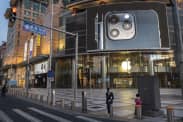Bank of America analysts are cautioning stock investors about betting the Federal Reserve will deliver interest rate cuts as inflation falls without a recession occurring in the wake of the central bank’s aggressive monetary tightening of the past year.
“Don’t go all in on recession-free cuts,” BofA Global Research analysts said in an equity derivatives report Tuesday. “The overhang of last year’s inflation fight and elevated data volatility and macro uncertainty may keep the Fed from cutting rates” until a slowdown arrives, they said.
The Fed could cut interest rates if a recession was to occur to help stimulate the economy. Market expectations for rates cuts “in advance” and “high equity valuations suggest an unusual lack of concern about the need to ease policy, setting a high bar for equities to keep rallying,” according to the note.
U.S. stocks have fallen so far this month but the S&P 500 index on Tuesday remained up 15.6% for the year, FactSet data show. The stock market has rallied and the U.S. economy has been resilient in 2023 even as the Fed continued raising rates to battle inflation.
“As economists and markets reduce expectations of further Fed hikes, investor focus is shifting to the timing and drivers of potential cuts,” the BofA analysts said. The 100 basis points of cuts expected by December 2024 are “half of what they were in May and would make for the slowest cutting cycle ever.”
Read: Long-term Treasury bond ETFs fall as Goldman Sachs forecasts rate cuts in 2024
Goldman Sachs Group forecast, in an Aug. 13 research note, that the Fed may start lowering rates in the second quarter of next year due to “a desire to normalize the funds rate from a restrictive level once inflation is closer to target, not by a recession.” U.S. economic analyst David Mericle said in the note that “normalization is not a particularly urgent motivation” for cutting rates and cautioned that Goldman also sees “a significant risk” that the Fed will hold its benchmark rate steady.
This year the Fed has become less aggressive in lifting its benchmark rate at its scheduled policy meetings, raising it by 25 basis points in July to a target range of 5.25% to 5.5%. While U.S. equities have been “more relieved about the slowing pace of Fed hikes,” the Bank of America analysts “still like protecting the downside,” according to the note, which cited long-dated S&P 500 “puts” as one way of doing so.
Put contracts give traders the option to sell securities at a specified price by a certain date.
Read: ‘Big Short’ trader Michael Burry loaded up on bearish options in second quarter, filing shows
Federal Reserve Bank of Minneapolis President Neel Kashkari on Tuesday questioned whether the central bank has done enough to bring inflation down after the progress it has made so far on that front through rate hikes. “The question on my mind is, have we done enough to actually get inflation all the way back down to our 2% target. Or do we have to do more,” Kashkari said during a discussion at the APi Group’s Global Controllers Conference.
Last year many investors worried the Fed’s aggressive rate-hiking campaign would trigger a U.S. recession, as the central bank aimed to cool the economy in a bid to tame high inflation. Meanwhile, the U.S. unemployment rate remains low this year and the economy continued to expand in the second quarter.
See: What recession? GDP speeds up to 2.4% in the spring
“A key question, though, is whether a recession is necessary for the Fed to cut rates,” the BofA analysts said. “Rising expectations of a recession-free Fed easing cycle open up left tail risks.”
The U.S. stock market closed sharply lower Tuesday, with the S&P 500 SPX falling 1.2% as investors digested fresh data showing retail sales were stronger than anticipated in July. The Dow Jones Industrial Average DJIA dropped 1% while the Nasdaq Composite COMP fell 1.1%, according to FactSet data.
In the bond market, the yield on the 10-year Treasury note BX:TMUBMUSD10Y rose 3.9 basis points Tuesday to 4.22%, its highest rate since October 2022 based on 3 p.m. Eastern Time levels, according to Dow Jones Market Data. Two-year Treasury yields BX:TMUBMUSD02Y dipped 1.1 basis point to 4.952%.






